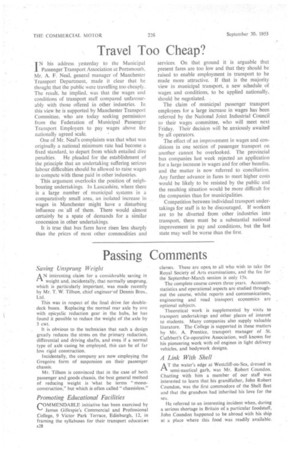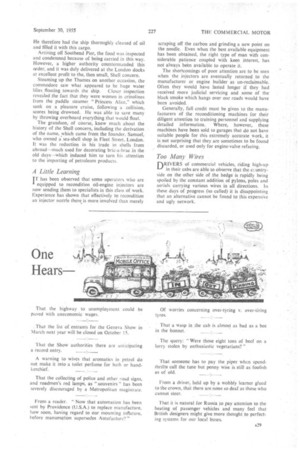Passing Comments
Page 30

Page 31

If you've noticed an error in this article please click here to report it so we can fix it.
Saving Unsprung Weight
A N interesting claim for a considerable. saving in " weight and, incidentally, that normally unsprung. which is particularly important, was made recently by Mr. T. W. Tillson, chief engineerof Dennis Bros., Ltd.
This was in respect of the final drive for doubledeck buses. Replacing the normal rear axle by one with epic yelic reduction gear in the hubs, he has found it possible to reduce the weight of the axle by 3 cwt.
It is obvious to the technician that such a design greatly reduces the stress on the primary reduction, differential and driving shafts, and even if a normal type of axle casing be employed, this can be of far less rigid construction.
Incidentally, the company are now employing the Gregoire form of suspension on their passenger chassis.
Mr. Tillson is convinced that in the case of both passenger and goods chassis, the best general method of reducing weight is what he terms "monoconstruction," but which is often called " chassisless."
Promoting Educational Facilities
COMMENDABLE initiative has been exercised by
James Gillespie's Commercial and Professional College, 9 Victor Park Terrace, Edinburgh, 12, in framing the syllabuses for their transport educatima A28 classes. These are open to all who wish to take the Royal Society of Arts examinations, and the fee for the September-March session is only 15s.
The complete course covers three years. Accounts, statistics and operational aspects are studied throughout the course, whilst reports and communications, engineering and road transport economics are optional subjects.
Theoretical work is supplemented by visits to transport undertakings and other places of interest to students. Many companies also supply valuable literature. The College is supported in these matters by Mr. A. Prentice, transport manager of St. Cuthbert's Co-operative Association, well known for his pioneering work with oil engines in light delivery vehicles, and bodywork designs.
A Link With Shell
A T the water's edge at Westcliff-on-Sea, dressed in
semi-nautical garb, was Mr. Robert Coundon. Chatting with him a member of our staff was interested to learn that his grandfather, John Robert Coundon, was the first commodore of the Shell fleet and that the grandson had inherited his love for the sea.
He referred to an interesting incident when, during a serious shortage in Britain of a particular foodstuff, John Coundon happened to be abroad with his ship at a place where this food was readily available. He therefore had the ship thoroughly cleaned of oil and filled it with this cargo.
Arriving off Southend Pier, the food was inspected and condemned because of being carried in this way. However, a higher authority countermanded this order, and it was duly delivered at the London docks at excellent profit to the, then small, Shell concern.
Steaming up the Thames on another occasion, the commodore saw what appeared to be huge water
lIlies floating towards the ship. Closer inspection revealed the fact that they were women in crinolines from the paddle steamer Princess Alice," which sank on a pleasure cruise, following a collision, scores being drowned. He was able to save many by throwing overboard everything that would float.
The grandson, of course, knew much about the history of the Shell concern, including the derivation of the name, which came from the founder, Samuel, who owned a sea-shell shop in Fleet Street, London. It Was the reduction in his trade in shells from abroad—much used for decorating bric-a-brac in the old days—which indnced him to turn his attention to the importing of petroleum products.
A Little Learning
IT has been observed that some operators who are I equipped to recondition oil-engine injectors are now sending them to specialists in this class of work. Experience has shown that effectively to recondition an injector nozzle there is more involved than merely scraping off the carbon and grinding a new point on the needle. Even when the best available equipment has been obtained, the right type of man with considerable patience coupled with keen interest, has not always been available to operate it.
The shortcomings of poor attention are to be seen when the injectors are eventually returned to the manufacturer or engine builder as un-reclaimable. Often they would have lasted longer if they had received more judicial servicing and some of the black smoke which hangs over our roads would have been avoided.
Generally, full credit must be given to the manufacturers of the reconditioning machines for their diligent attention to training personnel and supplying detailed information. Where, however, these machines have been sold to garages that do not have suitable people for this extremely accurate work, it is not surprising that they are sometimes to be found discarded, or used only for engine-valve refacing.
Too Many Wtres
DRIVERS of commercial vehicles, riding high-up in their cabs are able to observe that the ccuntryside on the other side of the hedge is rapidly being spoiled by the constant addition of pylons, poles and aerials carrying various wires in all directions. In_ these days of progress (so called) it is disappointing that an alternative cannot be found to this expensive and ugly network.




























































































